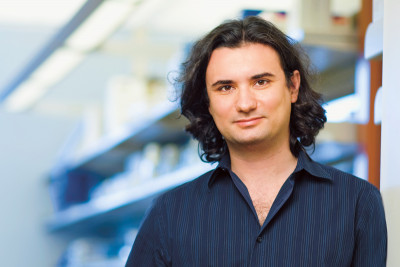
Andrea Ventura
Cancer biologist Andrea Ventura became fascinated with the machinery of genetics as a student in Italy and focused on cancer genes during postdoctoral work at the Massachusetts Institute of Technology (MIT). Now the incumbent of a Geoffrey Beene Junior Faculty Chair at the Sloan Kettering Institute, he devotes his research to the nascent field of microRNA expression, seeking to understand how these small RNAs act on genes to promote or suppress cancer.
I grew up in a small village on the east coast of Sicily. As a teenager, I became captivated by DNA and genetics. To me it was mind-boggling that a single cell, a fertilized egg, somehow contains all the information required to make a human being. I decided there wasn’t any better way to spend your life than trying to understand how it all worked.
I initially went to medical school in Italy, planning on practicing medicine like my father, but I realized I wasn’t that good at it. At the same time, I had come to realize I really liked research. During medical school, I did research at the University of California, San Diego, for several months. I really enjoyed the way of doing science in the United States, the lack of hierarchy and the degree of freedom I had. After completing a PhD at the European Institute of Oncology, in Milan, I kept thinking about how much I missed the United States and wanted to return to do research. I accepted an offer from MIT to work in the laboratory of Tyler Jacks, a leader in studying the genetic events that lead to cancer. He has been a fantastic mentor and has greatly influenced my career.
At MIT, I began following some of the new research being conducted on RNAs, single-stranded molecules involved in protein synthesis and sometimes in the transmission of genetic information. I became especially interested in microRNAs, which are a family of small noncoding RNAs known to modulate gene expression. Although microRNAs are pervasive throughout the animal and plant kingdom, the field is still very new — the first microRNA was discovered in the early 1990s. There is evidence that one microRNA can control the expression of hundreds of genes. If you think how pervasive this mode of regulation is, it’s really surprising that it’s gone undiscovered for so many years. It just shows that there’s still a lot to discover. We think we know everything that’s happening in the cell, but we really don’t.
I chose to study microRNAs that are suspected of being involved in tumor formation. A growing body of evidence was suggesting that altered microRNA expression is involved in the development and progression of human cancers. For example, one microRNA cluster, Oncomir-1, appears to be involved in the pathogenesis of B cell lymphomas and many other cancers. In the absence of Oncomir-1, the B lymphocytes fail to develop properly and die. And when you have too much Oncomir-1, the B cells proliferate too much and cause B cell lymphoma. This presents a strategy for treating cancers by modifying microRNA function. One way is to design short nucleic acids that bind to the microRNAs and prevent them from acting on the genes. Or you can do the opposite: design a molecule that mimics the microRNA to boost its effect in the cell. I’m optimistic that within the near future we will have powerful ways of exploiting this technology in live animal models and perhaps someday in human patients, too.
I wanted to continue investigating this area of research in a laboratory of my own, and I saw an opening in the Cancer Biology and Genetics Program at SKI. I arrived in 2008 to set up my lab and begin collaborating with other researchers here to further investigate micro-RNAs, especially Oncomir-1. In December 2009, we published a study in Genes & Development showing that one particular microRNA within Oncomir-1, called miR-19, plays a critical role in promoting the survival of tumor cells, and it does this at least in part by downregulating the tumor suppressor gene PTEN.
An important implication is that, in theory, we could design antagonists of miR-19 to inhibit its function and potentially prevent some cancers. We don’t think the antagonists alone will be sufficient, because when we genetically inactivate miR-19 in cancer cells in mice the tumors eventually resume growth. But the tumors seem to be more sensitive to chemotherapy and other forms of stress, so perhaps using the antagonists along with existing treatments will be effective.
I am very lucky to have the chance to continue researching micro-RNAs and their links to cancer here at the Sloan Kettering Institute. I’ve enjoyed great interaction with the people here, and many of them have been quite open to discussing ideas and establishing collaborations. Also, Memorial Sloan Kettering’s facilities are fantastic. I think microRNAs need to be investigated in an entire organism, and the mouse facility is excellent, with staff who are very experienced with this technology. Finally, it’s great to be right next door to The Rockefeller University and Weill Cornell Medical College, which expose all of us to a wide range of scientific subjects and expand the collaborative possibilities.